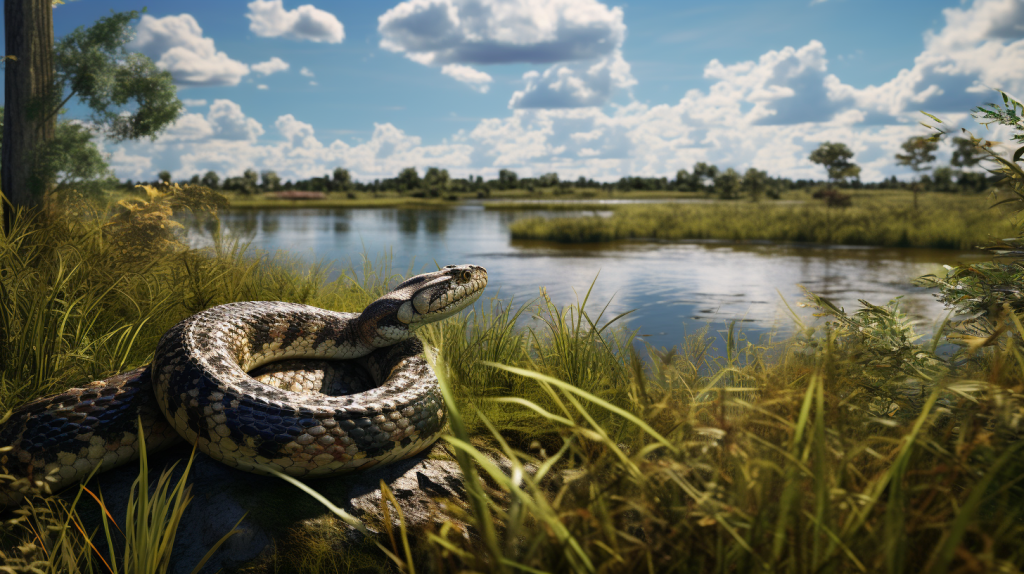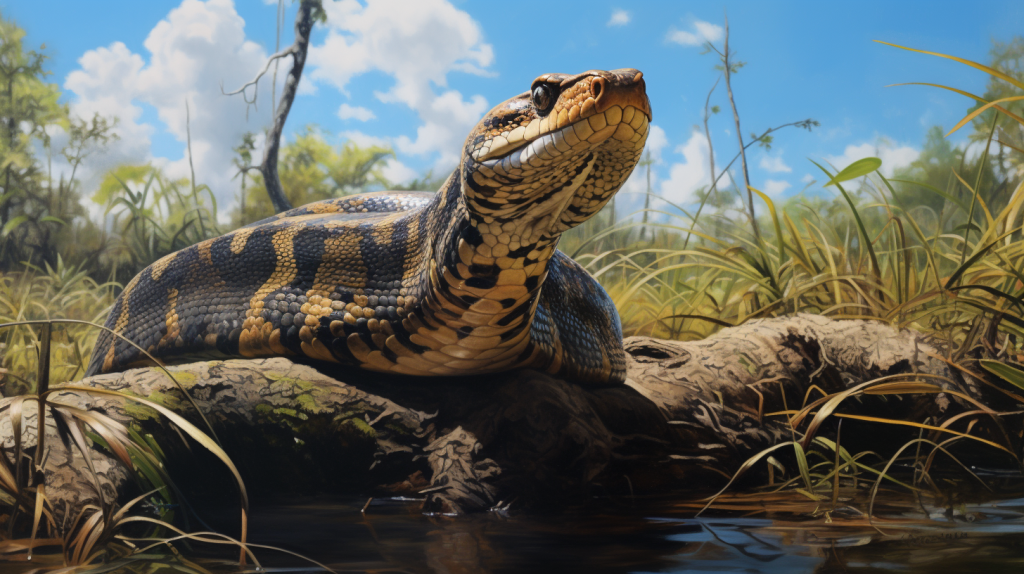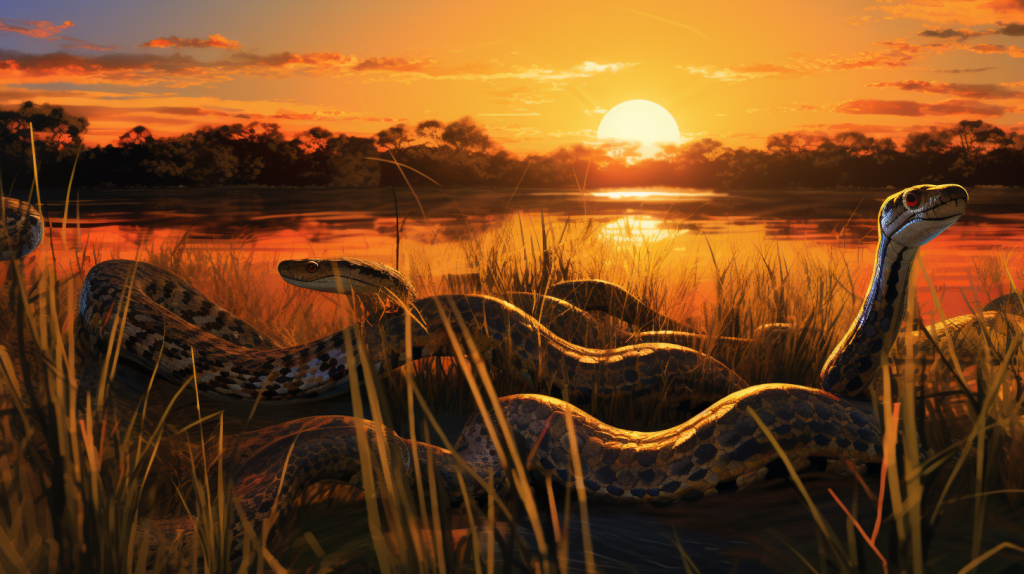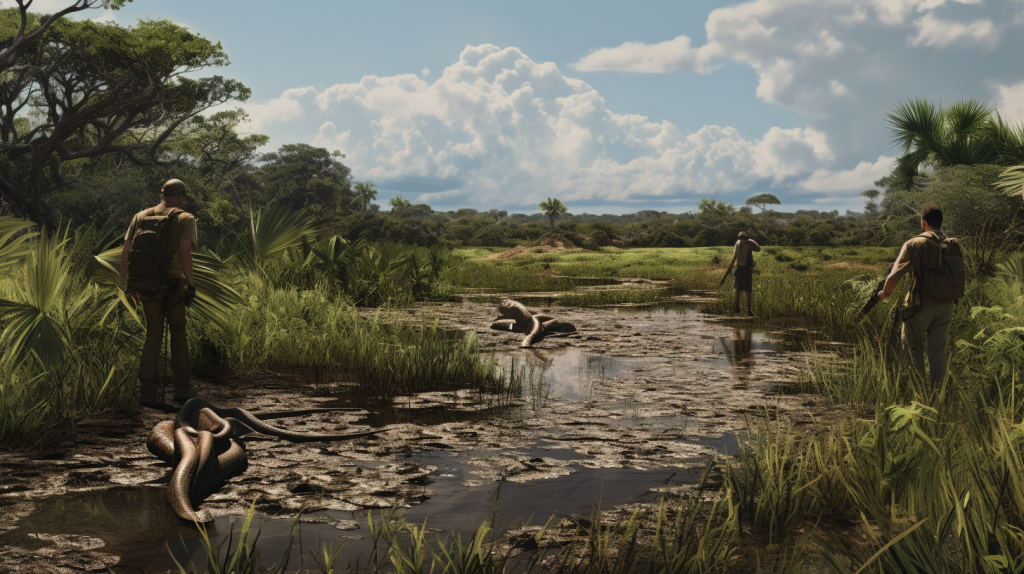Hey there, fellow nature enthusiasts! The discovery of the largest python in Florida ever recorded in this lush and enigmatic landscape carries serious consequence. Let us dive deep into the heart of the Florida Everglades today to unravel a fascinating and awe-inspiring story:
Picture this – a land of sprawling wetlands, diverse wildlife, and mysteries waiting to be uncovered. Our journey takes us through the perplexing world of pythons, where exploration meets the unexpected. So, let’s grab our metaphorical machetes and venture forth into the wilds!
Unveiling the Titan: A Record-Breaking Encounter
In the heart of the mesmerizing Florida Everglades, a team of intrepid researchers embarked on a journey that would forever alter our understanding of the region’s wildlife. Little did they know that their adventure would lead to a breathtaking discovery – a colossal Burmese python that would become a milestone in the annals of natural history. This extraordinary encounter unfolded like a scene from an adventure novel, captivating both scientists and nature enthusiasts alike.
Imagine the scene: the lush expanse of the Everglades, a landscape teeming with life and shrouded in mystery. Against this backdrop, the team of researchers stumbled upon a creature of awe-inspiring dimensions. As their eyes fell upon the python stretched out before them, the very air seemed charged with anticipation. This was no ordinary python; it was a record-breaking titan, an embodiment of the astounding diversity and marvels that nature conceals within its folds.
With a sense of wonder, the researchers set out to measure this slithery marvel, their hearts racing in harmony with the rhythm of the wild. The results of their measurements sent shockwaves through the scientific community – a mind-boggling length of 19 feet! As they meticulously recorded the python’s dimensions, they were capturing a moment that would forever alter our perception of the Everglades’ inhabitants. The python’s sheer size was not only a testament to the extraordinary conditions that allowed it to thrive but also a reminder of the enigmatic forces that shape life in this untamed paradise.
Contemplate for a moment the sheer magnitude of this discovery – almost 20 feet of pure reptilian majesty, a creature that defies expectations and stretches the boundaries of our imagination. In a world where size often equates to dominance, this Burmese python had earned its place as a true Everglades icon, a symbol of the remarkable biodiversity that exists in this unique ecosystem.
The ripples of excitement unleashed by this discovery reverberated far beyond the swamps and wetlands of Florida. The scientific community buzzed with discussions about the implications of this record-breaking python encounter. Enthusiasts and experts alike marveled at the resilience and adaptability of these creatures in a changing world. This encounter became a rallying point for those invested in preserving and understanding the intricate tapestry of life that the Everglades weave.
In essence, this simple expedition unfolded into an extraordinary revelation – a testament to the power of exploration, the wonders of nature, and the boundless curiosity that drives us to seek understanding. Who could have foreseen that a journey into the heart of the Everglades would lead to a rendezvous with a 19-foot titan, a python that challenges our perceptions and underscores the richness of our natural world? This record-breaking encounter stands as a beacon of discovery, an inspiration to uncover the mysteries that continue to unfold in the awe-inspiring realm of the Florida Everglades.
Perils of Pythons: Unraveling the Intrigue
As we delve deeper into the captivating realm of the Florida Everglades, the enigmatic growth of pythons unveils a tale as astonishing as it is perplexing. The question that arises is a natural one – how, in this seemingly improbable setting, do pythons manage to attain such astonishing proportions? The answer, my curious readers, lies in the intricate interplay between nature’s elements and the python’s unparalleled adaptability.
Consider for a moment the unique climate that blankets the Everglades – a blend of subtropical magic and abundant life. This distinctive setting, a canvas painted with wetlands and verdant expanses, serves as a thriving playground for a myriad of species. However, in this lush environment, a twist of fate has allowed the Burmese python to flourish in unexpected ways.
It’s all about the food. Plenty food finds its stage here, as the Everglades’ smorgasbord of prey provides pythons with a buffet fit for a king. Native wildlife, from small mammals to wading birds, teems in abundance, becoming unwitting participants in the python’s rise to apex predator status. This abundance, combined with the python’s opportunistic feeding habits, acts as a catalyst for their rapid growth – a growth that defies conventional expectations and boggles the minds of scientists and enthusiasts alike.
Here’s the clincher: the absence of natural predators. In their native Southeast Asia, pythons are part of a complex ecosystem, where checks and balances maintain their population. However, in the Everglades, a peculiar absence looms – the absence of creatures that would typically curb python numbers. An unbalance of predators once again takes center stage, as this lack of regulation allows pythons to seize the opportunity and establish themselves as top predators.
Imagine the domino effect – with no predators to curb their population, pythons proliferate, impacting native species and disrupting the delicate balance of the ecosystem. The intrigue deepens as the tale unfolds – an invasive species not just surviving, but thriving, in a land far from its origins. The pythons’ rise to dominance raises questions about the dynamic forces that shape ecosystems and challenges our understanding of the intricate web of life.
In the heart of the Everglades, where unexpected alliances form and pythons grow to astonishing lengths, the stage is set for a narrative of both peril and fascination. Burstiness, in all its unpredictable glory, threads through the tale, guiding the trajectory of an invasive species that has rewritten the rules of the game. As we grapple with the consequences of this ecological upheaval, one thing becomes clear: the python’s relentless march is a reminder that nature’s intricacies are never as straightforward as they seem.
Conclusion: Largest Python In Florida
In the south of the country, the largest python in Florida ever recorded serves as a symbol of the complex and dynamic nature of our world. Persistence and perplexity intertwine as we navigate the fascinating interactions between pythons, native species, and the delicate ecosystem that binds them together.
From battles of apex predators to the resilience of nature’s adaptations, every facet of this story emphasizes the intricate web of life that defines the Everglades. As we continue to explore and understand this unique environment, let’s remember the vital role we play in its preservation, ensuring that the wilds remain alive with wonder for generations to come.
FAQs About Largest Python In Florida
Q1: Is the largest python discovery a threat to humans?
A: Not typically. While pythons are large and powerful, they generally avoid human interaction.
Q2: How are scientists dealing with the python invasion?
A: Scientists are employing various strategies, including python hunts and detection dog programs, to manage the python population.
Q3: What impact do pythons have on native species?
A: Pythons disrupt the natural predator-prey balance, affecting the populations of native species such as birds and mammals.
Q4: Are there any efforts to restore the ecosystem’s balance?
A: Yes, education and action are crucial. Raising awareness about the python invasion can curtail pet releases, while organized hunts help control their numbers.
Q5: How can I contribute to preserving the Everglades?
A: Support conservation efforts, raise awareness about invasive species, and practice responsible outdoor recreation to minimize your impact on the ecosystem.
References:
- National Park Service. (n.d.). Burmese Python. https://www.nps.gov/ever/learn/nature/burmese-python.htm
- University of Florida IFAS Extension. (2022). Invasive Species: Burmese Pythons. https://edis.ifas.ufl.edu/uw392
- The Nature Conservancy. (n.d.). Pythons in Florida. https://www.nature.org/en-us/what-we-do/our-insights/perspectives/pythons-in-florida/
- Florida Fish and Wildlife Conservation Commission. (2022). Burmese Python. https://myfwc.com/wildlifehabitats/nonnatives/reptiles/burmese-python/
- United States Geological Survey. (n.d.). Burmese Pythons in Florida. https://www.usgs.gov/centers/wetland-and-aquatic-research-center-warc/science/burmese-pythons-florida?qt-science_center_objects=0#qt-science_center_objects





